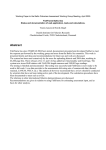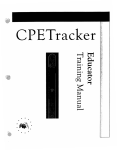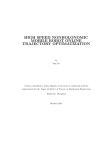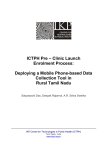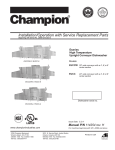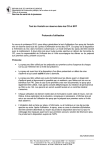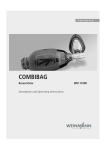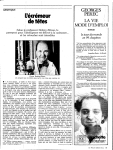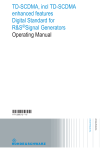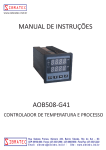Download Science Policy Interface for Coastal Systems Assessment
Transcript
Project N° : 036992 ACRONYM : Science Policy Interface for Coastal Systems Assessment DELIVERABLE D11.3 Documentation of the communication with SSAs (Report) WORK PACKAGE : WP11 Communication and Dissemination REPORTING PERIOD : From : Month 1 To : Month 6 PROJECT START DATE: 1st February 2007 DURATION : 48 Months Date of Issue of this report : 30 July 2007 Document prepared by : Partner 7 EUCC-Med Integrated Project funded by The European Community Under the Sixth Framework Programme Priority 1.1.6.3 Global Change and Ecosystems Science and Policy Integration for Coastal System Assessment Results of Communication workshop with SSAs “Virtual Workshop for SPICOSA Communication Team Members” FP- 036992 Deliverable 11.3 Draft – 30 July 2007 I. Lucius, M. Ferreira (EUCC) – WP11 coordinator This project is supported by the European Commission within the sixth Framework Programme, Global Change and Ecosystems Science and Policy Integration for Coastal System Assessment RESULTS OF COMMUNICATION WORKSHOP WITH SSAS Report of Telewebconference Monday, 25th of June 2007 “Virtual Workshop for SPICOSA Communication Team Members” The Workshop took place using Disy conferencing services, which allows the sharing of power point presentations through the internet. Maria Ferreira and Irene Lucius of EUCC – Mediterranean Centre prepared, chaired and assisted the workshop. 22 participants from 16 countries participated actively. For list of participants see Annex 1. The Workshop itinerary was based on the Programme Outline (see Annex 2) mailed to all participants before the virtual meeting. However, the meeting ended at 16.30, earlier than expected, because the participants felt that they needed more time to digest the information and preferred a follow-up event. Before the meeting, participants were briefed about the technicalities through an e-mail (see Annex 3), including provision of a comprehensive User Manual step by step to log-in the Virtual workshop (Annex 4, also available for download at internal website – revised version) and individual telephone coaching. The following power point presentations were given and uploaded unto the internal SPICOSA website: 1) The SPICOSA Communication Plan 2) The Local Communication Plan 3) Introduction to media relations 4) Introduction to writing a good press release 5) Introduction to non-media communication. 6) Individual assignments. The results of a brain storming session about defining target audiences of the SSAs were summarised in an additional power point presentation (also available in internal website). All SSAs are requested to formulate their own key messages as part of the Local Communication Plan. Other individual assignments were outlined in a power point presentation (see above). A model press release was distributed in two versions, one showing the final look, the other pointing out important visual and structural elements of a press release (see Annex 5). During the discussions, it was pointed out that • the Communication Plan has produced a template for planning and monitoring events where SPICOSA is presented. This overview is published on the internal SPICOSA website. • a standard power point presentation on SPICOSA is to be made by EUCC and will soon be downloadable from the internal website for everyone to use • communication is also part of WP6 (e.g. a workshop on stakeholder analysis). Close cooperation is needed between WP 6 and WP 11 leaders. • The SPICOSA poster presented at the Barcelona workshop can be downloaded from the internal SPICOSA website and used/adapted by everyone • Regard communications not as a necessary exercise but a way of securing sustainability and mobilising follow-up funding Conclusions about the virtual workshop: • With this conference app. 5 tons of CO2 emissions have been spared. This is roughly half of what an average European spends annually. • 8000 euros were saved by holding this workshop virtually. The feedback from participants was quite positive. After the initial technical problems of getting all the participants linked up and reducing back ground noises, the workshop went smoothly and efficiently. However, the event was regarded as being a bit too long. Four hours were regarded as a good length of time for a virtual telephone conference. The participants voiced their interest in repeating such a workshop in late autumn in order to share first experience with their communication work. 2/18 Science and Policy Integration for Coastal System Assessment Some feedback received: • Well prepared • Useful way of communicating among SSAs • Way of practicing what we preach • Practical and cost effective • It’s not like the real thing but a good alternative • It was good to get used to this new technology. Once we know how to use it, it works fine • Good new way of communicating Some way of extending and improving the virtual workshop technology was gathered: • Let´s think of other ways of using this technology, e.g. would be handy if people could dial in at large SPICOSA conferences when they can´t come and/or store presentations as podcasts. • Do some research to find out whether it is possible to listen through a headset • Need to improve the technical manual after this first experience gained. 3/18 Science and Policy Integration for Coastal System Assessment Annex 1: List of participants VIRTUAL WORKSHOP FOR SPICOSA COMMUNICATION TEAM MEMBERS Participants List No. SSA CZ Host/ partners name Partner No. Contact Telephone EMAIL Virtual Workshop (webconference) Participant number 7 Irene Lucius 00493074684397 [email protected] 1 7 Maria Ferreira 0031715122900 [email protected] 2 7 Carolina Perez 0034932247340 [email protected] 3 IFREMER 1 Daniel Roy 0033229008522 [email protected] 4 KMGNE 24 Anne Mette, Joachim Borner 00493029367942 [email protected] 5 Cardiff Un. 15 Jeanette Reis, Rhoda B, Hance S. 00442920876671 [email protected] 6 EUCC-MED 1 Gulf of Riga Est. Marine Inst., UT 31 Timo Arula 003724434456 [email protected] 7 4 Himmerfjärden SU 18 Jakob Walve 00468161730 [email protected] 8 5 Limfjorden DIFRES 30 Henrik Jarlbæk 004533963300 [email protected] 9 6 Sonderled IMR 28 Einar Dahl 004737059040 [email protected] 10 8 Cork NUIC 13 Andy Scollick 00353214703135 [email protected] 11 9 Scheldt DELFT 37 Jannette Van Buuren 00310703114357 [email protected] 12 11 Guadiana UALG-CIMA 11 Tiago Garcia 00351289800926 [email protected] 13 13 Thau IFREMER 1 Thierry Laugier 0033499573289 [email protected] 14 14 Taranto IAMC-CNR 3 Antonellla Petroceli 0039994542200 [email protected] 15 4/18 Science and Policy Integration for Coastal System Assessment VIRTUAL WORKSHOP FOR SPICOSA COMMUNICATION TEAM MEMBERS Participants List No. SSA CZ Host/ partners name Partner No. Contact Telephone EMAIL Virtual Workshop (webconference) Participant number 16 Thermaikos HMRC 20 Christos Anagnostou 0030 22910 76369 [email protected] 16 17 Izmit MRCTUBITAK 10 Asli Donertas 00902626774378 [email protected] 17 18 Danube Delta IES-JRC 41 Lyudmila Kamburska 00390332786728 [email protected] 18 7 Clyde Sea SAMS 22 Tavis Pots 00441631 559415 [email protected] 19 15 Venice CORILA 5 Pierpaolo Campostrini, Simona D.R. 00390412402511 [email protected] 20 VITO 6 Guy Engelen 003214335907 [email protected] 21 DEEMO UoG 27 Hanna Ladkowska 0048585236871 [email protected] 22 2 Gulf of Gdansk 5/18 Science and Policy Integration for Coastal System Assessment Annex 2: Final Programme ( 1 day : 25th June 2007) Objectives: To train Communication Team members in fulfilling their SPICOSA related communication tasks To streamline the SPICOSA communication style and strategy. To agree on mechanisms for collecting feedback from the stakeholders and channelling this information back to the Node 1 team in order to allow for adjustment at the conceptual level. Establishing format for reporting on communication activities Participants: One representative per Study Site (preferably the dedicated Communication and Training Officer) One representative of WP1, 6, 12, 13 Lead: EUCC Programme Outline Responsible partner Time (GMT+1) Issue 10.00 – 10.30 Welcome, introductory round, technical announcements EUCC, all 10.30 – 11.00 The SPICOSA Communication Plan, Q&A EUCC 11.00 – 11.30 The local communication plan (): draft structure, Q&A EUCC Coffee break Defining target audiences & key messages: brainstorming Introduction to media relations, Q&A EUCC, all 11.30 – 12.00 12.00 – 12.30 12.30 – 13.00 13.00 – 14.00 Lunch break 14.00 – 14.15 Summary of results so far Introduction to writing a good press release, Q&A Introduction: Non-media communication, Q&A Plenary discussion about press releases, media relations and non-media communication: open questions, sharing ideas Attribute individual assignments*: writing a press release for each study site, define list of study site media contacts, tactics for individual sites for media and non-media relations, define key messages per study site Final round of questions, remarks about telephone workshop, conclusions 14.15 – 14.45 14.45 – 15.30 15.30 – 16.30 16.30 –17.00 17.00-17.30 EUCC Realisation Dial-in telephone conference. Shared application: photos of participants (in ppt format) Shared power point, all need access to computer with internet access Shared power point, all need access to computer with internet access All off-line Telephone conference, moderated discussion Shared power point Off-line EUCC Shared power point EUCC Shared power point EUCC Telephone conference, shared ppt presentation All Moderated telephone conference EUCC Telephone conference, shared ppt presentation All Telephone conference, moderated * Deadline will be define to deliver the individual assignments. EUCC will collect all information and there will be a follow-up e-conference (to be schedule in two weeks time) for presentation of individual assignments and discussions. Materials such as templates and FP6 Visibility rules will be distributed separately. th Updated & prepared by EUCC – Mediterranean Centre team, 15 May 2007. 6/18 Science and Policy Integration for Coastal System Assessment Annex 3: Information provided prior to the virtual workshop Email sent: 16.052007 Technical requirements and preparations : we would like to inform you that we will be using DISY Web Conference system (http://www2.teleconf.de/english.html ). You will find the minimum requirements and instructions attached. Please check: - Touch tone Telephone and PC - if your telephone has a loudspeaker that would be perfect so that you will be able to work hands free. - Guide for participants in Web conference (see .pdf attached) In order to prepare the workshop introduction, please provide us in advance with: - Your complete profile (name, telephone number where you will be reached for the tele-conference and organization of communication officer/participant), - Summary CV (2 to 3 sentences who you are and what you have done professionally), and - photo of participant Email sent to : ALL SSAs contacts, and leaders of WP 1, 6, 12 and 13 From: Maria Ferreira [mailto:[email protected]] Sent: Friday, June 22, 2007 5:49 PM To: [email protected]; [email protected]; [email protected]; [email protected]; [email protected]; [email protected]; [email protected]; [email protected]; [email protected]; [email protected]; [email protected]; [email protected]; [email protected]; Asli Donertas; [email protected] Cc: [email protected]; [email protected]; [email protected]; Denis Bailly Subject: Manual & Participants details: Communication virtual workshop Dear Communication Team members, In addition to our previous instructions, (guide and programme update) hereby we provide you the final information and preparations for the Virtual Communication Workshop coming monday at 10.00h (= 9.00h UK / Portuguese time; 11.00h Turkish time). Make sure you will join the conference on time! Attached you will find 2 documents, as follows: i - List of participants & contact details (annex 1): please double-check your personal details (telephone & email address) and in case there are mistakes please inform us prior to Monday 10h and we will correct it. ii - A comprehensive User Manual step by step to log-in the Virtual workshop (tele/web conference) in order to make all steps clear and that we will have a smooth start and development of the tele/webconference. We strongly recommend you to print out these documents before the conference starts! Furthermore, you will receive an e-invitation (automatic email) soon with your details and access code to the web-conference (note that these details are case sensitive). We hope to have provide you with useful information. If you have any questions let us know. Looking forward to a fruitful e-workshop, Best wishes, Maria on behalf EUCC Communication Team E-mail: [email protected] 7/18 Science and Policy Integration for Coastal System Assessment Annex 4 – User Manual Tele/Web Virtual Workshop USER MANUAL TELE/Web Virtual Conference STEP BY STEP LOG-IN This manual aims to guide you through the steps to get connected to the DISY webconference. You will receive prior to the conference an automatic e-invitation from the moderator - Subject of the email automatic invitation will be: Telephone conference on XX.XX.200X, XX:XX (CEST) This email message will provide your personal details to log in the web-conference, such as: Name: xxxx Email address: xxxx Code of access to the conference: xxxxx PLEASE NOTE that you must log in with the exact details as provided in email invitation. Then the following steps should take place: 1. After you will be connected to the telephone conference, please go to your web-browser and visit www.teleconf.de The website will automatically open in German language so select English language as presented below (red arrow) 8/19 Science and Policy Integration for Coastal System Assessment 2. Then click to tab “Participant login” in the Login section on the screen Insert your name, email and access code provided by the conference automatic invitation email – login 3. You will then be connected to the web-conference. continue 9/18 Science and Policy Integration for Coastal System Assessment 4. In the Welcome screen, click on overview or participants list (red arrow) This will open an extra (resizable) window, which shows all the participants and their status…. 10/18 Science and Policy Integration for Coastal System Assessment The tele/web-conference has started and the host /moderator will guide through the sessions and will display the slide presentations and Q/A sessions! 5. To view the slide presentations you will have to start this from your Welcome window. Below a screen shoot of a slide presentation 11/18 Science and Policy Integration for Coastal System Assessment GOOD LUCK! 12/18 Science and Policy Integration for Coastal System Assessment Additional information as result of feedback and experience gained at “Virtual Workshop for SPICOSA Communication Team Members”- 25th June For moderators: - Call all participants shortly before the conference – this ensures all participants and sites are on and can test the audio technology of their telephone. Introduce yourself. If time permits and depending upon the size of the group, have the other participants introduce themselves as well so that people can get used to the voices of their colleagues. Begin by requesting that all participants/sites mute their microphones if not already muted. This cuts down on noise interference. Establish ground rules for asking questions or providing information. Have the participants mute the microphones until they ask a question. Conversations on the side, moving paper, and any small noise will be projected at other sites unless microphones are muted. avoid connection with mobile phones as noise interferences are too disturbing and the participant using a mobile has difficulties in listening and participating. For participants: - if you are sharing an incoming telephone line with others, make sure nobody is blocking the line for the time the conference is scheduled switch on your computer and link to the internet before the conference starts unmute the microphone, announce your name and the location prior to speaking. There is a slight delay, be sure the person is finished speaking before you speak. Also pause from time to time to allow for questions. Keep the microphone muted when not speaking unless told otherwise. Avoid unnecessary movement, side conversations, or the creation of other distracting noise during the time you are unmuted. if your telephone microphone is not good enough, talk through the receiver move other phones away from the phone you are using in order to avoid interferences 13/18 Science and Policy Integration for Coastal System Assessment Annex 5: Model Press release & instructions for press releases Press release 25 June 2007 European coastal researchers met successfully without emitting climate gases Barcelona, Spain – Twenty scientists from across coastal Europe met virtually for a one-day workshop to discuss ways of improving communication between researchers and the coastal community. The event took place in the framework of the EU project SPICOSA. All participants were surprised about how efficiently a conference can be conducted by telephone and internet. A face-to-face meeting would have caused 18 people to travel, thereby emitting approximately XY tons of carbon. SPICOSA, a project funded by the European Union’s Research Programme FP6, develops tools to better analyse and understand the interaction between people and nature of Europe’s coast. This will ultimately help coastal decision takers to manage coastal resources in a more sustainable manner. As only good communication between SPICOSA researchers and coastal stakeholders can guarantee that results of the project will be put to use, the virtual workshop provided training on how to distribute the messages and results of SPICOSA effectively. “Partners of the SPICOSA project not only do research for sustainable coastal development, they also want to lower their own impact on the environment” said Tom Hopkins, scientific coordinator of SPICOSA. “This virtual workshop has shown how modern communication technology can help us to do so”. The teleworkshop was moderated by EUCC – Mediterranean Centre, an NGO based in Barcelona, Spain, and one of the 54 SPICOSA partners. It used a new software programme, which makes it possible to link up to 50 people by telephone and to share power point presentations that all participants can see on their computer screens. After this successful test application, the SPICOSA project is planning to hold more expert events as virtual meetings. 14/18 Science and Policy Integration for Coastal System Assessment - ENDS FOR MORE INFORMATION Irene Lucius EUCC – Mediterranean Centre Tel. +34 932247340; Fax. +43 932247341 Email : [email protected] NOTES FOR EDITORS SPICOSA is an EU Integrated Project that will strengthen research throughout the European region and produce products of use to society. The Project’s goal is to create an operational framework for delivering prognostic assessments of policy options for the sustainable management of coastal zones. Achieving this objective will require a restructuring of the science and methodology needed to understand and to quantify the response of coastal zones to changing environmental and anthropogenic conditions and the resulting impacts on ecosystem services. It will also demand integration of disciplines and of geographic, political, and social scales. The methodological product is called the Systems Approach Framework (SAF). It is based on an adaptation of the Systems Approach that incorporates the ecological, social and economic dimensions of the coastal zones together with emerging concepts on system complexity. The SAF is designed to be readily updateable, to provide an accumulative knowledge base for wider and more complex applications, and to contribute to a growing understanding the options and actions necessary for the transition to sustainable development. The project started in February 2007 and will last for four years. More details can be found on www.spicosa.eu 15/19 Science and Policy Integration for Coastal System Assessment Always put your press release on letterhead and always remember to include the EU flag, SPICOSA and Sixth Framework Programme logo Always write at the top of your document that it’s a press release. Press release Always include the date. Otherwise journalists won’t know whether it is recent news. 25 June 2007 Use a short, catchy and concise title – fewer than 10 words. European coastal researchers met successfully without emitting climate gases Always write the name of the city where the release is issued from. Barcelona, Spain – Twenty scientists from across coastal Europe met virtually for a one-day workshop to discuss ways of improving communication between researchers and the coastal community. The event took place in the framework of the EU project SPICOSA. All participants were surprised about how efficiently a conference can be conducted by telephone and internet. A face-to-face meeting would have caused 18 people to travel, thereby emitting approximately XY tons of carbon. What is important about the press release? Write one or two sentences that will draw the reader in. Remember to get the point across as quickly as possible. 16/18 Science and Policy Integration for Coastal System Assessment SPICOSA, a project funded by the European Union’s Research Programme FP6, develops tools to better analyse and understand the interaction between people and nature of Europe’s coast. This will ultimately help coastal decision takers to manage coastal resources in a more sustainable manner. As only good communication between SPICOSA researchers and coastal stakeholders can guarantee that results of the project will be put to use, the virtual workshop provided training on how to distribute the messages and results of SPICOSA effectively. The use of quotes provides journalists with direct material that can be used in an article. Don’t forget to include a message in your quote. “Partners of the SPICOSA project not only do research for sustainable coastal development, they also want to lower their own impact on the environment” said Tom Hopkins, scientific coordinator of SPICOSA. “This virtual workshop has shown how modern communication technology can help us to do so”. More and more detail is added to the press release as it goes on The teleworkshop was moderated by EUCC – Mediterranean Centre, an NGO based in Barcelona, Spain, and one of the 54 SPICOSA partners. It used a new software programme, which makes it possible to link up to 50 people by telephone and to share power point presentations that all participants can see on their computer screens. After this successful test application, the SPICOSA project is planning to hold more expert events as virtual meetings. This tells journalists that the press release is finished. It should be at the end of your text and before the “for more information” section. -ENDS- These are the contact details of the spokesperson and/ or PR person that is authorised to speak on the record or provide additional information about the press release to journalists. Ensure that the contact information is correct and that the people listed are available that day. This should be written in smaller font than the press release – normally 10 points. FOR MORE INFORMATION Irene Lucius EUCC – Mediterranean Centre Tel. +34 932247340; Fax. +43 932247341 Email : [email protected] These boilerplates have information about the project and SPICOSA. You should always have both at the end of your press release. NOTES FOR EDITORS 17/19 Science and Policy Integration for Coastal System Assessment SPICOSA is an EU Integrated Project that will strengthen research throughout the European region and produce products of use to society. The Project’s goal is to create an operational framework for delivering prognostic assessments of policy options for the sustainable management of coastal zones. Achieving this objective will require a restructuring of the science and methodology needed to understand and to quantify the response of coastal zones to changing environmental and anthropogenic conditions and the resulting impacts on ecosystem services. It will also demand integration of disciplines and of geographic, political, and social scales. The methodological product is called the Systems Approach Framework (SAF). It is based on an adaptation of the Systems Approach that incorporates the ecological, social and economic dimensions of the coastal zones together with emerging concepts on system complexity. The SAF is designed to be readily updateable, to provide an accumulative knowledge base for wider and more complex applications, and to contribute to a growing understanding the options and actions necessary for the transition to sustainable development. The project started in February 2007 and will last for four years. More details can be found on www.spicosa.eu 18/19




















